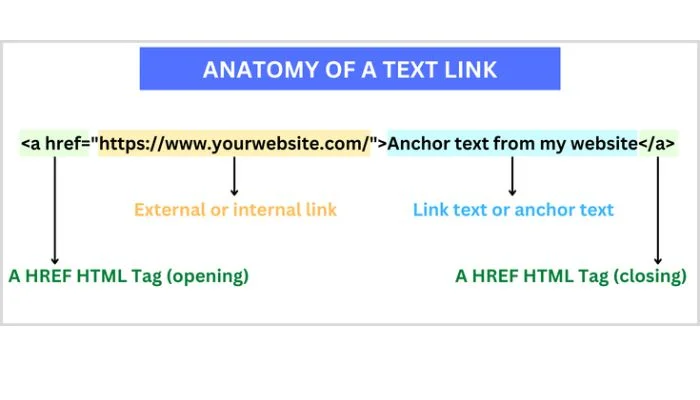What Are External Links?

External links are an important and useful tool when creating digital content for websites. Also known as outbound links, external links direct users to other websites by clicking on a link embedded within web page material or through various HTML coding.
External links can improve the quality of online media by providing easily accessible information that helps to establish the credibility and authority of blogs or articles.
In this article, we'll take a closer look into the definition of external linking, understand its function and importance in making content more engaging and boost SEO efficiency even further — while taking proper precautions against spammy websites.
Ultimately, an effective use of external linking will benefit both website visitors who receive high-quality information - alongside improved search engine rankings for having interesting subsisting site linkages pointing back towards it, in return.
Understanding External Links

External links connect websites to other web pages that are hosted on different domains. Put simply, they point from one webpage or website to another using hyperlinks, allowing internet users to traverse multiple pages and websites simultaneously.
An external link is typically signified by the website name in blue with an indicator such as an arrow or chevron escorting it at the end – both of which are known as anchor text. While clickable images may also constitute external linking, most external links you see online today tend towards being textual but visual depictions serve a similar purpose at times.
Differentiating external links from internal links
Differentiating external links from internal links is relatively simple. External links are URLs that take web users away from the currently viewed site to another one on a different domain. These can often be identified by link text containing an embedded URL denoted by a color and an underline or another prominent effect highlighted in comparison to the surrounding content.
Internal links, on the other hand, link users to varied pages within the same website domain and guide visitors through each page in scope for the desired context found at any particular instant. Both of these link types provide great benefits for SEO while providing increased navigation avenues to users when correctly employed.
Functions of External Links
Directing users to other websites

External links are an effective avenue to direct users from your website to a specialized resource elsewhere. This transfer of web traffic can create awareness for both websites and grow user engagement on both platforms.
Additionally, providing external links to products and services you offer or using more help boost revenue given the referral placed from redirecting users back to their respective homesites.
External techniques for directing users also contain incentives for customers, such as discounts or coupons, ensuring that they click through your external link should it serve its purpose well enough.
Ultimately, shooting off into another virtual realm is suggested when addressing topics outside of one's primary field of knowledge, directing visitors and helping them explore further in search of supplementary and valid means of information.
Enhancing user experience
External links are a powerful tool for enhancing user experience across many types of online websites and content. They allow users to transition seamlessly between related digital pages, often providing necessary context or relevant information that can clarify and support the purpose of hyperlinked texts.
Furthermore, using external links point users to stay in a single context more easily: instead of being overwhelmed with separate pieces of information at one time within the same page—which can be manually taxing at times—details and resources can be found through external website references accessed by clicking on an external link all while never changing page content!
In this way, proper use of integrated external linking ensures a smooth end-user consulting or browsing experience as desired.
Improving search engine optimization (SEO)
External links are great for improving a website's SEO. Websites and webpages with more external site links tend to rank higher in search engine results; thus, they get increased visibility and more visitors.
Similarly, major search engines can also use the external links of a domain as "votes" indicating the authenticity or domain authority (which itself could influence rankings). The content linked back to should also contain good quality in order to reap an adequate benefit for SEO.
Therefore, adding carefully researched external links can help boost a content page's ranking within SERPs (Search Engine Result Pages) – leading to better organic results for both parties involved.
Establishing credibility and authority
Establishing credibility and authority is one of the key functions of external links. By linking to trusted sources, reliable websites, and reputable journals in content online, authors are adding verification, authenticity, and expertise to their written works.
External links demonstrate that an author has done extensive research into a given topic or field; this adds weight to their articles as legitimate resources about said topics.
A resource-filled page is also more likely to be credited by search engines like Google—ranking higher in research results, which can lead to increased website traffic.
Moreover, not only do external links provide valuable information for readers while they're consuming digital content; but it also shows competence and prepares them with additional learning materials should they want to explore further.
How External Links Work
HTML code and anchor tags

External links use HTML code and anchor tags to reference outside pages. Anchor tags are the elements within codes that indicate which text should link to other websites, indicated by an "href" followed by a URL (example: http://www.examplewebsite.com).
External links open up in their own tab or window when properly coded using the "target" attribute set as "_blank." It is important to double-check the function of external links on webpages; browser plug-ins like CheckMyLinks allow site owners to quickly check if all anchor tags are valid and functioning.
Target attribute and opening links in new tabs/windows
External links direct users to other websites using hyperlinking, which depends on HTML code, including anchor tags and its target attribute. The target attribute places the linked web page in either the same browsing tab/window or a new one.
Using this also impacts how users form an impression of both your website originating from yours and from another's website opening. It is even monitored in SEO as recent algorithms could look for signals assigning relevancy according to whether you maintain certain internal vs external parameters paying attention to how they load & open up within a seamless manner.
Best Practices for Using External Links
Ensuring relevance and context
When using external links, it's important to ensure that users will find the page relevant and interesting.
Consider linking out to content that provides strong support for your own, adds contextual information, or fills in gaps where readers of your article can learn more about a certain concept. Ensure the sites you're linked to have trustworthy content associated with accurate visuals and videos.
Continuous use of irrelevant links could be counter productive as readers might view such links as worthy only in terms of SEO instead of relevance and context. Linking strategically by pointing out relevant resources is key for having an effective external link strategy.
Checking for broken or outdated links
One of the best practices for using external links is to ensure they are updated by regularly checking them for broken or outdated information. This helps maintain credibility with audiences, as visitors will trust a website that makes an effort to make sure all content is accurate and up-to-date.
Checking external links also ensures visitors are sent to appropriate websites at any moment, rather than a link leading readers to a webpage that no longer exists or leads elsewhere. Additionally, practicing this habit allows one's digital content overall quality to both look and be more professional than when these matters are neglected.
Using proper anchor text
One of the best practices for users to follow external links is using proper anchor text. Anchor text is simply the clickable part of a hyperlink, which may appear in different forms such as regular and bolded texts.
It's paramount to use keyword-rich anchor text when linking externally because it not only carries more explicit information but also gives you an edge in SEO rankings. Furthermore, avoid keyword stuffing within your anchors and opt for brand and natural keywords featured prominently on page body contents.
Balancing the number of external and internal links
Balancing the number of internal and external links is an important best practice to ensure quality online content.
Too few external links restrict user experience by preventing users from learning more about outside sources, while too many distract users from original content with overwhelming clicking opportunities. It's also necessary to do efficient link tracking and evaluation for optimal performance.
When utilized properly, using a balanced amount of both external links and internal links can help streamline content, direct users to the relevant information quickly, foster relationship building between websites, boost SEO value and generate website traffic.
Therefore, digital editors should constantly monitor the correct balance between external and internal link counts for website accuracy, making sure it's at its peak form.
Conclusion
In conclusion, external links are important components of online content. SEO optimization and the credibility of a website greatly benefit from their presence in blogs, articles, videos, and more. After reading this outline piece, readers should understand what exactly external links are and how they work, given the information about the HTML code associated with them.
Moreover, practicing the best use for these links, such as relevant context to prioritize user experience, is critical for ensuring they function adequately when clicked on.
Lastly, there should be a limitation with regard to link ratios, as too many are earmarked for another website that conflicts with the core messages an organization may be proposing. External link building affects overall efficacy in becoming visible in SEO, so optimize where one sees fit before moving forward.


.svg)

.jpg)
.jpg)
.jpg)